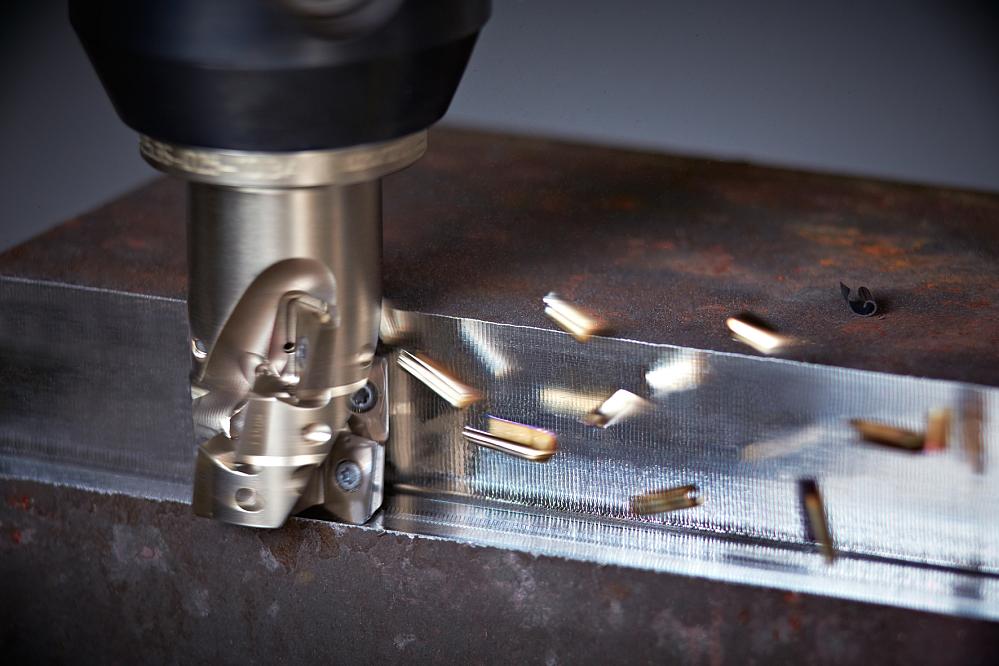- FMA
- The Fabricator
- FABTECH
- Canadian Metalworking
Business of tooling: high-feed milling, tips and tricks
A new trend in high-feed milling is the use of rectangular inserts. This means the cutter body can have a higher density of inserts per diameter.
- By Canadian Metalworking
- January 29, 2014
- Article
- Cutting Tools
High-feed milling has revolutionized milling applications today. High-feed milling works from a chip thinning principle using the lead angle of the cutter.
A 90 degree cutter will produce an average chip thickness of the programmed feed rate. When you program a feed rate of 0.010 inch per tooth the average chip thickness will be 0.010 inch. In a 45 degree lead cutter the average chip thickness is about 70 per cent of the programmed chip per tooth. In high-feed milling the average chip thickness is about 15% of the programmed feed per tooth.
Therefore a programmed feed rate of 0.060 inch per tooth will generate an average chip thickness of only 0.009-inch. The lead angle also has a major effect on the cutting forces. With a 90 degree cutter the cutting forces act perpendicular to the spindle.
The net result is the forces are trying to push the spindle and or part away. This is very hard on the spindle. The tool should extend from the spindle the minimum amount to avoid deflection.
A 45 degree lead cutter will have the cutting forces act at 45 degrees to the spindle and the part. This is an improvement, however care should be taken when machining a thin part as the forces may try to push down on the part and cause “oil canning”.
Oil canning is where the cutter pushes the workpiece down and the material springs back after the cutter passes. With high-feed milling the cutting forces act almost parallel with the spindle. Since the cutting forces are directed back up into the spindle it is easier on the machines spindle and the cutter can be run at extended lengths.
High-feed milling is a very versatile way to remove material. The tool can ramp and interpolate. Unlike many other types of milling, this means the tool never has to leave the part. The tool can simply be ramped down to the
next level while continuing to mill.
Since the tool is never lifted from the part, it reduces the probability of re-cutting a chip and breaking an insert. High-feed milling is now commonly used for hole making. High-feed milling is about six times faster than drilling and one tool is capable of producing numerous size holes, reducing cycle time to index to different drill diameters, reducing the cost of the additional tools and reducing tool inventories.
Care should be taken when selecting the size of the high-feed cutter. Often programs use very short 'jerky' motions when creating its tool path. When these short jerky motions occur it is often difficult for the machine to ramp up to the desired feed rate. For example a three diameter cutter may be programmed to run at 300 inches per minute but since the short jerky movements don’t allow enough travel for the machine to reach this speed the cutter may only average forty inches per minute.
Whereas a one inch diameter cutter may reach the 300 inches per minute of feed rate since its tool path is longer. Although the one inch diameter cutter has three times the distance to travel it is doing so seven and a half times faster, making the one-inch cutter much faster than the three-inch cutter.
Many CNC controls today have a safety feature that limits the maximum feed rate. Many shops put in a new high-feed cutter, program the feed rate for 250 inches per minute or more and have the false sense that they are running faster yet are not because the maximum feed rate is set to 150 inches per minute.
A new trend in high-feed milling is the use of rectangular inserts. The benefit of this style of insert is that it does not take up as much space in the cutter body as would a trigon or square type of insert. This means the cutter
body can have a higher density of inserts per diameter.
Some cutting tool manufacturers have cutter bodies with five inserts in a one inch diameter or 10 inserts in a two-inch diameter. With a chip per tooth of 0.060-inch, five effective cutting edges and elevated RPM due to the small one inch diameter the tool is easily capable of running at feeds exceeding 600 or 700 inches per minute.
With metal removal rates as high as that the cutting forces produced are tremendous, some cutting tool manufacturers have opted to build a big bulky insert to prevent insert failure.
While this may offer some shock resistance, it limits the amount of effective teeth, thereby slowing the process. Other manufacturers have opted to make their high-feed inserts much more positive and reduces the cutting forces which maintains super high-feed rates, reduces cutting forces and is easier on the machine’s spindle.
About the Author
subscribe now


Keep up to date with the latest news, events, and technology for all things metal from our pair of monthly magazines written specifically for Canadian manufacturers!
Start Your Free Subscription- Industry Events
ZEISS Quality Innovation Days 2024
- April 15 - 19, 2024
Tube 2024
- April 15 - 19, 2024
- Düsseldorf, Germany
Lincoln Electric's Large Format 3D Metal Printing Seminar
- April 16 - 17, 2024
- Cleveland, OH
CTMA Economic Uncertainty: Helping You Navigate Windsor Seminar
- April 30, 2024
- Windsor, ON Canada
MME Winnipeg
- April 30, 2024
- Winnipeg, ON Canada





















